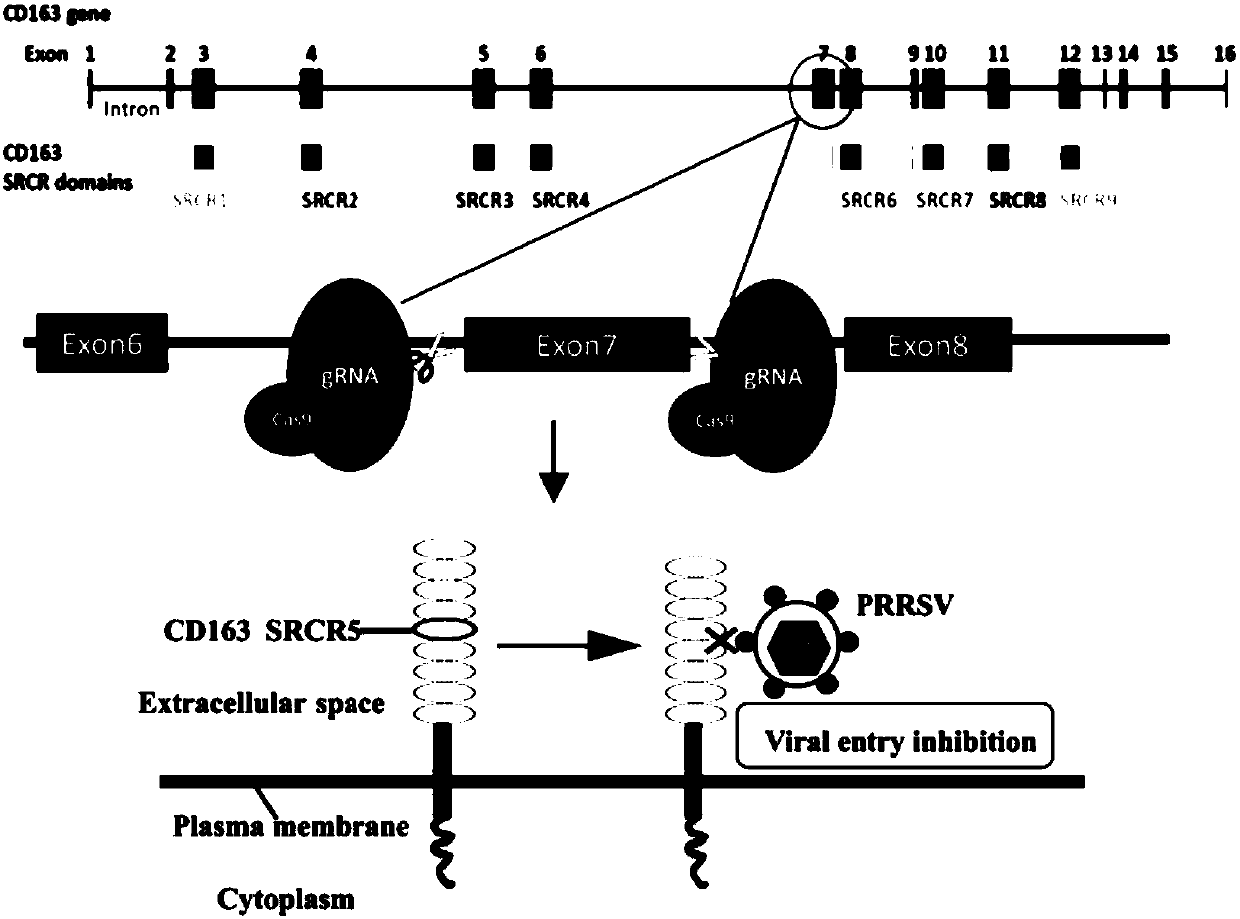Porcine reproductive and respiratory syndrome resisting Marc-145 cell line as well as preparation method and application thereof
A cell line and blue ear virus technology, applied in the field of cell genetic engineering, can solve the problems of destroying the body's immune system, preventing and controlling blue ear disease, and lack of good vaccines and drugs
- Summary
- Abstract
- Description
- Claims
- Application Information
AI Technical Summary
Problems solved by technology
Method used
Image
Examples
Embodiment 1
[0050] Example 1 CRISPR / Cas9 Targeting Vector Construction
[0051] 1. Design of sgRNA
[0052] In the intron region at both ends of exon 7 (sequence shown in SEQ ID NO.1) of the African green monkey CD163 gene (sequence number is XM_007967478.1), select the sgRNA to target the potential target region sequence, design the sgRNA sequence, and initially screen the selection Six better ones were selected as candidate sgRNAs, and the sequences are as follows in Table 1 and Table 2:
[0053] Table 1 Upstream primers (5′-3′)
[0054]
[0055] Note: The bold and underlined part is the sticky end.
[0056] Table 2 Downstream primers
[0057]
[0058]
[0059] Note: The bold and underlined part is the sticky end.
[0060] 2. Denaturation annealing and phosphorylation of sgRNA
[0061] Denature and anneal each pair of sgRNA single-stranded oligonucleotides synthesized into double-stranded oligonucleotide fragments, and add phosphate groups on both sides of the fragments fo...
Embodiment 2
[0066] Example 2 Electrotransfection of positive cloned cells into Marc-145 cells
[0067] 1. Before electrotransfection, the number of cells needs to be determined according to the experimental requirements (the number of cells required for each 100 μL system is 1×10 6 Left and right), and because electroporation has high requirements on cell state, it is necessary to ensure a good cell state.
[0068] 2. According to the cell passage procedure, after digesting the cells, centrifuge at 1600rpm for 4min, suck off the supernatant, add 1mL PBS to wash and count the number of cells with a cell counter. After counting, the PBS cell suspension was also centrifuged at 1600rpm for 4min, the supernatant was sucked off, and each 1×10 6 Add 100 μL of cell suspension R to the cells and pipette evenly. At the same time, add 8 μg of plasmid per 100 μL of cell suspension, and gently pipette evenly for later use.
[0069] 3. Prepare the culture dish for receiving cells after electrotransf...
Embodiment 3
[0073] Embodiment 3 flow sorting
[0074] 1. Cell preparation: 24 hours after electroporation, the fluorescence intensity is strong, and flow cytometry sorting can be performed. Remember to prepare a negative control. Digest the adherent PEF cells with trypsin, centrifuge at 1600rpm for 4min, suck off the supernatant, resuspend with PBS, pipette evenly and set aside.
[0075] 2. Filter the cell suspension through a 50 μm nylon membrane into the flow tube to prevent clogging of the flow sorter. At the same time, prepare the culture dish for receiving positive cells, and then prepare for the machine.
[0076] 3. Analyze the fluorescence ratio and intensity of the cells on a FACScalibur flow cytometer. Note that for EGFP and DsRed double-positive cells, in addition to setting double-negative cell controls, single-positive cells need to be prepared to ensure the accuracy of the sorting.
PUM
 Login to View More
Login to View More Abstract
Description
Claims
Application Information
 Login to View More
Login to View More - R&D
- Intellectual Property
- Life Sciences
- Materials
- Tech Scout
- Unparalleled Data Quality
- Higher Quality Content
- 60% Fewer Hallucinations
Browse by: Latest US Patents, China's latest patents, Technical Efficacy Thesaurus, Application Domain, Technology Topic, Popular Technical Reports.
© 2025 PatSnap. All rights reserved.Legal|Privacy policy|Modern Slavery Act Transparency Statement|Sitemap|About US| Contact US: help@patsnap.com



